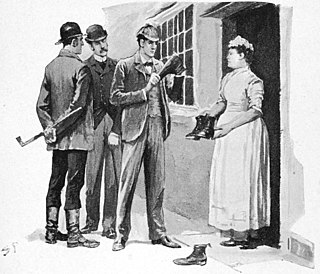
Detective fiction is a subgenre of crime fiction and mystery fiction in which an investigator or a detective—whether professional, amateur or retired—investigates a crime, often murder. The detective genre began around the same time as speculative fiction and other genre fiction in the mid-nineteenth century and has remained extremely popular, particularly in novels. Some of the most famous heroes of detective fiction include C. Auguste Dupin, Sherlock Holmes, and Hercule Poirot. Juvenile stories featuring The Hardy Boys, Nancy Drew, and The Boxcar Children have also remained in print for several decades.

Christianna Brand was a British crime writer and children's author born in British Malaya.
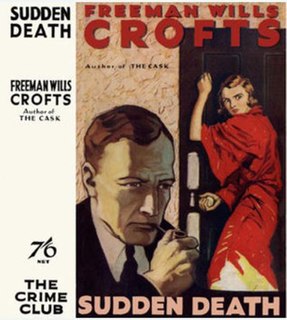
Sudden Death is a 1932 detective novel by the Irish writer Freeman Wills Crofts. It is the eighth in his series of novels featuring Inspector French, a prominent figure of the Golden Age of Detective Fiction.
Inspector Joseph French is a fictional British police detective created by Irish author Freeman Wills Crofts. French was a prominent detective from the Golden Age of Detective Fiction, appearing in twenty nine novels and a number of short stories between 1924 and 1957. The character was introduced in the 1924 novel Inspector French's Greatest Case, where he investigates a deadly diamond robbery in Hatton Garden. The series relied largely on puzzle mysteries.
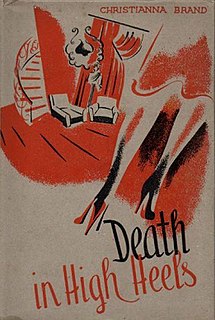
Death in High Heels is a 1941 crime novel by the British author Christianna Brand. Her debut novel, it featured the fictional police officer Inspector Charlesworth, a young detective with Scotland Yard. Charlesworth is called in when a young woman is murdered at an upmarket dress shop in London's Bond Street.
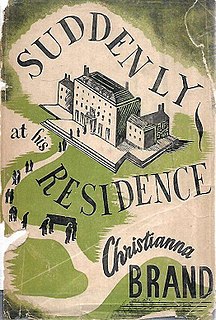
Suddenly at His Residence is a 1946 crime novel by the British writer Christianna Brand. It is the third in a series featuring her detective Inspector Cockrill. In the United States it was published using the alternative title The Crooked Wreath.
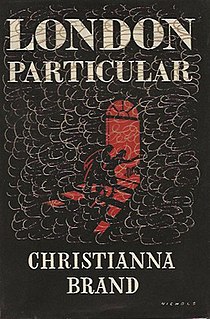
London Particular is a 1952 mystery crime novel by the British writer Christianna Brand. It is the fifth in a series of novels featuring her fictional police detective Inspector Cockrill and also portrays another of her characters Inspector Charlesworth. It was published in the United States in 1953 under the alternative title of Fog of Doubt.

Tour de Force is a 1955 mystery crime novel by the author Christianna Brand. It was the sixth novel in a series featuring the fictional police detective Inspector Cockrill. It was the last full-length novel in which Cockrill appears, although he features in some short stories. His sister Henrietta also features in the 1957 novel The Three Cornered Halo which uses the same setting as this work.

Constable Guard Thyself is a 1934 mystery detective novel by the British writer Henry Wade. It was the third in a series of seven novels featuring the character of Chief Inspector Poole, although it was preceded by the 1933 short story collection Policeman's Lot in which seven of the twelve stories had feaured Poole. After his more experimental novel Mist on the Saltings Wade returned to the traditional detective model.
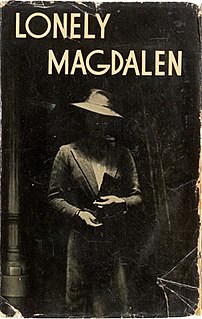
Lonely Magdalen is a 1940 mystery detective novel by the British writer Henry Wade. It was the fifth in a series of seven novels featuring the character of Inspector Poole, published during the Golden Age of Detective Fiction. The book focuses more closely on police procedural than the traditional puzzle format. There was a thirteen year gap between this and the next entry in the series Too Soon to Die.

Too Soon to Die is a 1953 mystery detective novel by the British writer Henry Wade. It was the sixth in a series of seven novels featuring the character of Inspector Poole, published during the Golden Age of Detective Fiction. It followed a thirteen year gap since the publication of the previous novel Lonely Magdalen.

Gold Was Our Grave is a 1954 mystery detective novel by the British writer Henry Wade. It was the seventh and last in a series of novels featuring the character of Inspector Poole, published during the Golden Age of Detective Fiction.
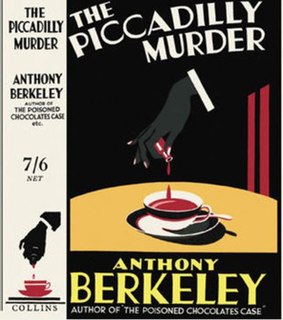
The Piccadilly Murder is a 1929 mystery detective novel by the British writer Anthony Berkeley. Berkley was a prominent writer during the Golden Age of Detective Fiction, known for his private detective Roger Sheringham series and his development of the inverted detective story. Although not part of the Sheringham series it featured the character of Chief Inspector Moresby of Scotland Yard who also appeared several times with Sheringham. Moresby reappeared with the chief protagonist Chitterwick in a sequel Trial and Error in 1937.

The Musical Comedy Crime is a 1933 mystery detective novel by Anthony Gilbert, the pen name of British writer Lucy Beatrice Malleson. It is the seventh entry of the series featuring Scott Egerton, her principal character before her better known creation Arthur Crook appeared three years later. A traditional whodunnit, it was published during the Golden Age of Detective Fiction.

The Murder on the Burrows is a 1931 detective story by E.C.R. Lorac, the pen name of the British writer Edith Caroline Rivett. Her debut novel, it introduced the character of Chief Inspector MacDonald of Scotland Yard who went on to appear in a lengthy series of novels during the Golden Age of Detective Fiction. Although initially named James this is changed to Robert in later books. It takes around Bideford Bay in North Devon where the author had spent several holidays.

Death at Dyke's Corner is a 1940 detective novel by E.C.R. Lorac, the pen name of the British writer Edith Caroline Rivett. It is the nineteenth in her long-running series featuring Chief Inspector MacDonald of Scotland Yard, a Golden Age detective who relies on standard police procedure to solve his cases.

Death of an Author is a 1935 detective novel by E.C.R. Lorac, the pen name of the British writer Edith Caroline Rivett. It is a rare standalone book by Lorac, not featuring Chief Inspector MacDonald of Scotland Yard who appeared in a lengthy series of novels during the Golden Age of Detective Fiction. It was her final novel published by Sampson Low before she switched to the more prestigious Collins Crime Club with whom she remained for the rest of her career.
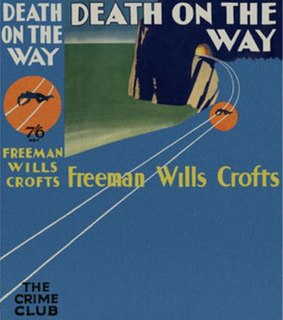
Death on the Way is a 1932 detective novel by the Irish writer Freeman Wills Crofts. It is the ninth in his series of novels featuring Inspector French, a prominent figure of the Golden Age of Detective Fiction. It was published in the United States the same year by Harper under the alternative title Double Death.

Poison for One is a 1934 detective novel by John Rhode, the pen name of the British writer Cecil Street. It is the eighteenth in his long-running series of novels featuring Lancelot Priestley, a Golden Age armchair detective. It combines elements of the locked room mystery and country house mystery. Reviewing the book in the Sunday Times leading crime writer Dorothy L. Sayers considered it "as usual, sound, pleasantly written, and entertaining" although she complained the book "was rather spoilt for me by the jacket, which deliberately gives away one-half of the solution."
Harry Martineau is a fictional British police detective created by Maurice Procter. He is a Chief Inspector in the industrial Northern city of Granchester, which was inspired by Manchester. Procter, himself a former police officer, wrote fourteen novels in the series published between 1954 and 1968. Martineau has been described as a transitional figure in detective fiction standing between the Golden Age detectives such as Ngaio Marsh's Roderick Alleyn and Josephine Tey's Inspector Grant and the newer fashion for police procedurals.


















